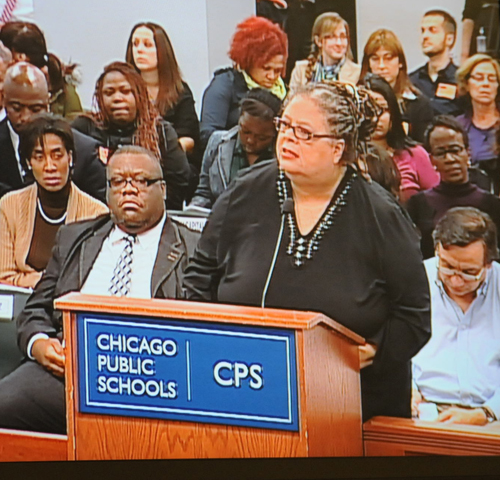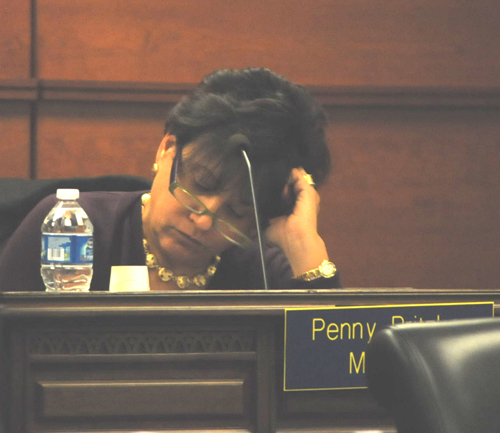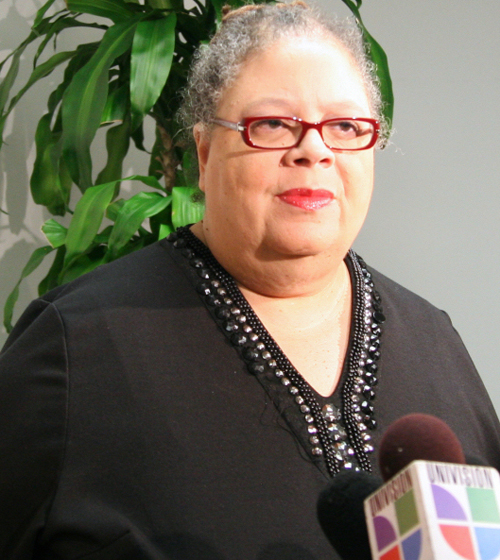CTU study shows class sizes in CPS among the highest in Illinois... CTU President Karen Lewis criticizes CPS over huge Chicago class sizes at Board of Education meeting
A few minutes after the latest iteration of corporate school reform had monopolized the beginning of the October 26, 2011 meeting of the Chicago Board of Education, the reality of children, teachers and classrooms returned to the Board's chambers when Chicago Teachers Union President Karen Lewis took the floor and presented the Board with a critique of the fact that CPS has the highest class sizes in the State of Illinois.
Lewis's remarks followed a lengthy Power Point presentation by two CPS officials with no real public school teaching experience, Noemi Donoso ("Chief Education Officer") and Oliver Sicat ("Chief Portfolio Officer"). Donoso and Sicat, apparently subbing for "Chief Executive Officer" Jean-Claude Brizard, presented the Board with a Power Point that claimed to prove that the majority of Chicago's real public schools were "failing" according to the new, converted, test and evaluation "matrices" developed since June 2011 by the new CPS administration. Donoso was appointed to her $195,000 per year job by the new Board in June 2011 after working in Denver (and received $21,000 in "relocation expenses" from the Board). Sicat was appointed to the newly created post of "Chief Portfolio Officer" at the Board's August 24, 2011 meeting at an annual salary of $162,000 per year.
After a series of perfunctory questions about the lurid Power Point report, members of the Board moved on to other business. Not one of the questions from Board members asked how Sicat and Donoso had been able to supposedly "convert" the ISAT and Prairie State test scores that had shown CPS making progress over the years to "Common Core" metrics that show, today, that a majority of CPS schools are "failing". One of the most interesting facts about the Board of Education and executive administration appointed by Mayor Rahm Emanuel is that it is going out of its way to claim that the previous 15 years of corporate school reform in Chicago have been a failure, and that only the latest direction — the "Common Core" and "College and Career Ready" — will provide Chicago school children with the chance of success.
 Chicago Teachers Union President Karen Lewis (above at podium) tried to explain to the members of the Chicago Board of Education that class sizes mattered more than the latest iterations of corporate school reform, which is now pushing the "Common Core." Citing a CTU report showing that Chicago class sizes are the highest in Illinois, Lewis suggested that the Board begin facing the real issues. Substance photo by George N. Schmidt.The CTU position was summarized in a press release issued by the union following the Board meeting:
Chicago Teachers Union President Karen Lewis (above at podium) tried to explain to the members of the Chicago Board of Education that class sizes mattered more than the latest iterations of corporate school reform, which is now pushing the "Common Core." Citing a CTU report showing that Chicago class sizes are the highest in Illinois, Lewis suggested that the Board begin facing the real issues. Substance photo by George N. Schmidt.The CTU position was summarized in a press release issued by the union following the Board meeting:
"CTU analysis shows Chicago's school class sizes are among the highest in the state
"CHICAGO -- A Chicago Teachers Union (CTU) analysis of Illinois classroom sizes showed early grade classrooms in the city are larger than 95 percent of the classrooms in the rest of the state. The analysis, using Illinois State Board of Education data, found that classrooms in the Chicago’s public high schools have the second highest class size compared to other districts in Illinois.
"The CTU analysis also found:
· Out of the 480 Illinois school districts with high schools, Chicago has the fifth largest average high-school class size. The only districts with larger average high school class sizes are Woodstock, Pikeland, Havana and CHSD 218 (Oaklawn).
· Chicago’s average class sizes at the early childhood grades (k-1) are larger than 95 percent of all Illinois school districts.
· (Chicago has the 12th highest avg class size at the early childhood (k-1) level. The school districts with higher class sizes at the early childhood level are Marengo-Union, Chaney-Monge, Arbor Park, Lemont-Bromberek, Darien, Mascoutah, Aurora East, Colona, Harrison, Massac, and Posen-Robbins. Only three of these are also in Cook County)
· Upon average across all elementary grades, Chicago has the 14th highest class size averaged across the elementary grades (k-8).
 Chicago Board of Education member Penny Pritzker, a billionaire, could barely contain her dislike of the Chicago Teachers Union during the remarks on class size by Karen Lewis. Above, Pritzker looked down and away during the entire time Lewis was speaking. Substance photo by George N. Schmidt.“'Reducing class sizes can lead to improved teaching and learning,” said CTU President Karen GJ Lewis. “In a smaller classroom, a teacher has more time to get to know each student's academic strengths and weaknesses; students receive more attention and teachers can spend more time helping students learn and working with parents.'
Chicago Board of Education member Penny Pritzker, a billionaire, could barely contain her dislike of the Chicago Teachers Union during the remarks on class size by Karen Lewis. Above, Pritzker looked down and away during the entire time Lewis was speaking. Substance photo by George N. Schmidt.“'Reducing class sizes can lead to improved teaching and learning,” said CTU President Karen GJ Lewis. “In a smaller classroom, a teacher has more time to get to know each student's academic strengths and weaknesses; students receive more attention and teachers can spend more time helping students learn and working with parents.'
"Tennessee’s Project STAR (Student Teacher Achievement Ratio) found that smaller class sizes had a positive effect. At each grade level (K-3), across all school locations (rural, urban, inner city, suburban), on every achievement measure and for all subjects (reading, mathematics, science, social science, language, study skills), the small-class students exceeded their peers in regular and regular/aide classes.
 Karen Lewis spoke to the press about the union's concerns following her remarks on the class size problems in CPS schools during the October 26, 2011 Board of Education meeting. Substance photo by David Vance."The study also found that students assigned to small classes in early grades graduated on schedule at a higher rate (76 %) than students from either the regular classes (64%) or the regular cases with an aide (70%). The same students also completed school with an honors diploma more often than students from regular classes and dropped out of school less often (15 %) compared to the regular classes (24%).
Karen Lewis spoke to the press about the union's concerns following her remarks on the class size problems in CPS schools during the October 26, 2011 Board of Education meeting. Substance photo by David Vance."The study also found that students assigned to small classes in early grades graduated on schedule at a higher rate (76 %) than students from either the regular classes (64%) or the regular cases with an aide (70%). The same students also completed school with an honors diploma more often than students from regular classes and dropped out of school less often (15 %) compared to the regular classes (24%).
"Recently, parents have contacted CTU about concerns about class size. Until early October one third grade classroom at Cassell Elementary, 11314 S. Spaulding, had 42 students in a single class. The matter was resolved internally when the administration and teachers agreed to develop a second/third grade split class. Chicago is the only district whose union is not allowed to bargain over class size. The 1995 School Reform Act included a list of topics that were either prohibited or permissive of bargaining, meaning the Union can bargain over the impact of class size but the not actual class size.
“'We know from studies and teacher experience that particularly at the lower grade level, students in smaller classes get off to a better start in their schooling because the teacher is able to modify her instruction to meet the needs of individual children and their parents, said CTU researcher Carol Caref.

